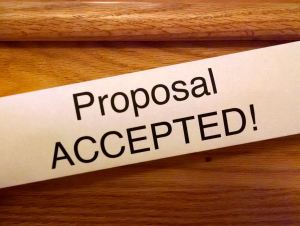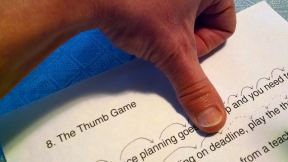The Perfect Presentation Proposal in 9 Easy Steps
Posted: February 6, 2015 Filed under: Uncategorized | Tags: conference proposal, presentation proposal, proofreading 5 Comments Long ago, partly due to the high cost of attending conferences, including hotel bills, travel expenses, and registration fees, I decided I would attend only those conferences that included me as a speaker.
Long ago, partly due to the high cost of attending conferences, including hotel bills, travel expenses, and registration fees, I decided I would attend only those conferences that included me as a speaker.
Why? Because when I’m a speaker, I have extra motivation to learn more about a topic and to prepare the best conference presentation possible. When I’m a speaker, I hear valuable feedback from audience members. When I’m a speaker, I contribute to the organization’s mission.
Today I share what I have learned over the years about conference proposal writing. If you follow my advice, you’ll soon be wearing one of those snazzy speaker nametags and adding lines to your curriculum vitae.
1. Bull’s Eye Aim
The perfect presentation proposal is aimed exactly, like a bull’s-eye, towards the theme of the conference and towards the subdivision of the conference that might be responsible for reviewing the proposal. Some conferences have strands, others have divisions, still others have departments or networks. A large organization always breaks itself down into bits, and parcels out the proposal review responsibilities to committees.
You need to know exactly what group of people will be reviewing your proposal, and how that committee will be reviewing your proposal. If you cozy up to one of the members of the committee (or someone who served on the committee in the past) and ask for a rubric, so much the better. If the organization is transparent enough to post the rubric on their website, for goodness sakes follow it to perfection.
2. Catchy Title with Promise
Make sure your presentation proposal has a catchy title that includes a promise to participants of what they will learn, and a promise that attending the session will be a valuable use of their time.
3. Flawless Grammar
The perfect presentation proposal has flawless grammar to ensure that even if a grammar police officer sits on the proposal review committee, you’ll get as many points as possible towards winning one of the coveted presentation spots.
The perfect presentation proposal promises that participants will leave the session with useful tools, strategies, or whatever synonym you can find at the time to promise usefulness. The perfect presentation proposal lists enough of those tools, strategies, or whatnots to entice not only the reviewing committee to choose your proposal, but also to entice conference attendees to choose your session.
5. Strength in Numbers
To ensure success, submit as many proposals for the conference as the organizers allow. If the conference allows people to submit only two proposals as a lead presenter, collaborate with other people in the field to submit joint proposals. If you know enough people in your field, dream up the perfect panel, which includes a variety of viewpoints on a controversy facing members of the organization.
6. Novelty
If you think the organization wants novelty heading in a particular direction, go in that direction. Find out what controversies are currently facing the organization. Determine what fields outside the organization might help resolve those controversies. Learn as much as you can from those outside fields, and come up with a proposal that promises to teach conference goers new information that might help resolve a controversy.
7. Share Early and Often
Of course, submit your proposals on time. Aim to finish them at least a week in advance, and use that last week to send them around to friends for careful editing, proofreading, and suggestions. Don’t be shy about sharing your work with others. Think of it this way: if you don’t share your work with others before you submit your work, whatever embarrassing errors your friends may catch will be the downfall of your proposal, or if your proposal is accepted, may be your own downfall if no one takes pity on you and edits your proposal before it’s published. Always, always, get as much editing and proofreading help as you can. (Get more help than I’ve gotten as I’m rushing to publish this article ahead of a major proposal deadline facing many of my friends.)
8. The Thumb Game
 If your advance planning goes belly up and you need to do your own proofreading on deadline, play the thumb game. I learned the thumb game from Matthew Bagley, a well-loved teaching colleague of mine in England. He taught his sixth grade students to take the thumb on their right hand and place it upside down on top of the first word in the paper to be proofread. The thumb must then be moved from word to word as the mind stops and savors each word, its spelling, and its relationship to the words around it.
If your advance planning goes belly up and you need to do your own proofreading on deadline, play the thumb game. I learned the thumb game from Matthew Bagley, a well-loved teaching colleague of mine in England. He taught his sixth grade students to take the thumb on their right hand and place it upside down on top of the first word in the paper to be proofread. The thumb must then be moved from word to word as the mind stops and savors each word, its spelling, and its relationship to the words around it.
The thumb game had other details designed to catch punctuation and capitalization errors, but I’ll spare you that level of detail. The important thing is to remember that your mind plays tricks on you. You may think that you have read every word in your proposal, but as you were reading, your mind likely filled in the gaps with what you had hoped to see on the paper. You simply cannot proofread and edit your own work. Trust me, I’m a mistake-making champion. As an example, I’m giving you this blog article before it’s 100% ready.
9. Beware of Your Success
Try to learn the usual success rate of proposals submitted to the organization. Once you master the art of writing perfect presentation proposals, expect a higher than average success rate.
How high? Expect your chances of success to double, or even triple. During my years of reviewing conference proposals, I found few that met my high standards for rubric-following, grammar-perfecting, novelty-offering, research-citing, and strategy-giving. You can do better. Much better.
Be careful, though. Trust me…you do not want to spend your entire conference time polishing and delivering presentations rather than enjoying the presentations of others. Pay attention to whether the organization makes you promise to present in the event your proposal is accepted, or whether the organization has a process whereby after your proposal is accepted, you are given a chance to accept or reject an invitation to present.
If the organization does not have a process for opting out after you submit your proposal, be prepared for all of your proposals for a certain conference to be accepted. In that case you’re going to be one busy beaver during that particular conference and in the weeks leading up to that conference. Make sure you’re prepared to present all those sessions. If you can’t act like a super hero, don’t submit so many perfect presentation proposals, ok?
Good luck!


Very helpful advice and coming at just the right time, as we prepare proposals for NAGC.
Thanks for your feedback. I’m glad you found the advice helpful.
Great advice! I am just now putting my NAGC proposals to bed. See you in Phoenix!
Congratulations on submitting your proposals. I look forward to meeting you.
Thanks you! This is fantastic and timely information for me. One of my goals is to present at a conference next year. I’ve never applied to do it before. I am looking forward to using this post as a resource when submitting my proposal.